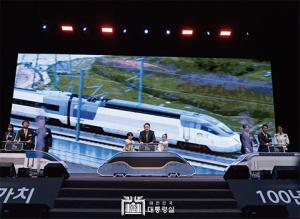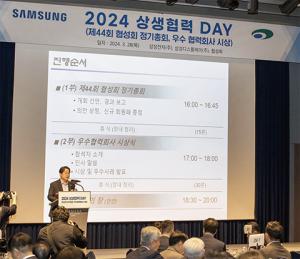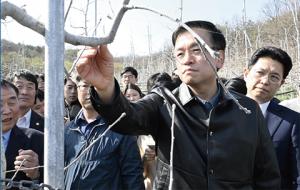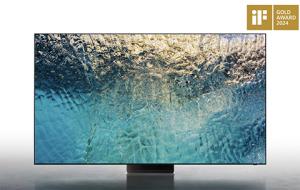 |
||
| ▲ 願 - 희망, 41x30, 장지 분채, 석채, 2016 | ||
“삶과 치유의 경계에서 전통 채색의 깊은 맛과 멋을 발효시켜
오묘한 색상을 표현하는 채색화를 그리다”
김미희 화가
우리나라의 채색화는 고구려 고분 벽화에서 조선 민화까지 다양한 스펙트럼을 가지고 계승되어 왔다. 동양의 원색인 오방색과, 수채화와 유화의 속성을 모두 아우르는 채색화는 서양인들에게 한지위에 올린 채색화가 매우 독특한 개성과 아름다움으로 다가갔다고 한다. 김미희 화가의 작품세계는 이러한 채색화에서 발효색채의 질료 감각과 여인을 소재로 한 테마를 꾸준히 전개한 좋은 예이다.
오래 공들여 발효시켜 깊은 질감을 낸 색으로 여인을 표현하다
화려하고 고혹적인 색감으로 국내외에 많은 팬을 거느리고 있는 김미희 화가는 대학 졸업과 동시에 전통채색화 그룹 ‘채묵화회’를 창립하여 색채의 질감을 표현하는 연구를 계속해 왔다. 동양화의 색감을 서양화와 접목하는 시도로서 전통한복의 염색이나 오방색 등 다양한 명도와 채도로 나타내는 채색화라는 한 우물을 파 온 것이다. 홍콩 아트페어, 뉴욕 햄튼 아트페어, 한국국제아트페어 등에 출품한 김 화가의 그림들은 장지 위에 석채, 분채를 표현하는 방식으로 제작되었다. 천년을 견뎌내는 전통 한지인 장지 위에, 색이 배어나도록 수백, 수천 번 칠하여 깊고 힘있는 맛과 멋을 가진 발효된 색상이 나타나기에 오랜 시간이 지나도 변하지 않는다고 한다. 분채란 가루분 재질의 물감을 오일이 아닌 아교를 매개제로 삼아 만드는 것인데, 개어내는 방식이 마치 떡이나 과자를 만들 때와 비슷하여 아교, 분채, 석채를 준비하는 일은 조리 과정을 떠올리게 하는 부분이 있다. 이렇게 만든 작품에는 알갱이 질료들이 쌓이면서 서로 반사되어 발색되는 효과가 있어, 작가는 이를 인내를 감수해 가며 완성된 작품에 강렬한 색채의 힘이 내재된 비법으로 삼기도 한다. 화선지에 붉은 색을 칠하면 물 먹은 분홍이 되기 때문에, 보이는 대로 색감을 표현하려면 수많은 붓질이 필요하다.
이렇듯 김 화가의 질료를 대하는 관념이 이토록 완성도를 향해 열의를 보이고 있기에, 이러한 질감으로 표현하고자 하는 대상을 ‘여인’으로 정한 것은 어쩌면 필연적인 일이다. 한국의 여인상은 한과 인내, 이해에 대한 대표적인 상징성을 띠고 있고, 김 화가의 <願(원하다)> 시리즈의 여인들이 아이를 안고 있건, 홀로 있건 누군가를 기다리는 표정으로 희망을 향한 사색을 거두지 않는 것은 소재와 주제에 대한 일관된 표현주의로 요약할 수 있을 것이다. 김 화가의 석채, 분채 작법에서 2010년 작 <願-희망>에 표현된 보리밭은 푸른색과 녹색이 강조되어 바람(風)에 흔들리는 보리들의 바람(희망:希望)을 떠올리게 한다. 여인의 한이란, 기다림에 지쳐 서럽디 서러운 울음이 아니라 그 끝자락에 내일의 빛을 그리는 법이기에 김 화가 역시 한때 어둡고 우울한 그림을 그린 적이 있었지만, 여인의 강인한 생명력 표현에 천착하기 시작하면서부터는 그림에서 밝은 면, 희망을 말하기 시작했다고 한다. 그리고 그 희망 다음에는 치유(힐링)의 메시지와 해석을 담기 시작했다.
화가는 색으로 시대를 읊조리는 시인, 색으로 시대성을 관조하는 철학자다
김 화가의 작품은 모딜리아니의 ‘긴 목’을 지닌 여인의 우울함, 화가 본인이 직접 영향을 받았다고 말하는 고갱의 인물화처럼 토속적이고 고개를 돌려 소통하려는 여인의 모습이 두루 표현되어 있다. 김 화가는 꽃과 달항아리, 여인의 측면을 배경으로 삼은 <願-희망> 연작에 대한 소재를 통해 여인의 생명성을 표현하려고 했으며, 작가 자신의 성별과 정체성을 표현할 때 스스로 공감할 수 있으며 나타내기 쉬운 대상이기 때문이라고 전한다. “작업을 하기 전, 언제나 라디오를 켜고 음악을 듣는다. 아픔과 세파에 흔들리지 않는 여인의 느낌은 포르투갈의 민요 파두(Fado)에서도, 우리의 아리랑에서도 존재한다. 전통에 내재된 그 한의 정서를 공통적으로 느낀다. 그리고 현대적인 몸의 미학을 표현할 때, 신윤복의 미인도를 현대화한 新미인도의 느낌도 담으려 한다” 그래서 소녀의 측면을 서정적으로 표현한 것만큼이나 승화된 어머니의 사랑을 담은 모자상도 많이 그렸다고 한다. 여인을 집중적으로 그리게 된 이유에는 인물화 중 슬픔과 한을 끄집어 낼 대상 역시 여성이기 때문이었다고 한다. 그렇게 그림은 2010년도 개인전을 계기로, 한으로부터 치유로 전환하게 된다. “동양화를 하는 사람은 관념과 철학으로 형식을 지켜 가는데, 나의 경우는 시대성을 반영하고 책, 뉴스, 드라마, 일상생활을 접하며 생기는 상념과 문제의식 등 철학을 그림으로 표현한다고 보면 된다. 또한 현대미술은 그림으로 자기 삶과 정체성을 드러내야 한다” 작품 <4월의 숨결>에서 김 화가는 자신이 좋아하던 푸른 바다의 이미지보다는 꽃의 이미지를 택했다. 벚꽃과 장미가 피어나는 4월은 누군가에겐 깊고 차가운 바다를 떠올리게 하는 아픈 계절이기에. 세월호의 아이들을 갓 피어난 분홍 장미로, 그리고 노란 리본으로 대비시켜 이제는 천사가 되어 있을 아이들의 흔적을 아름다움으로 표현하여 많은 이들을 위로하고자 했다.
어릴 적 자연을 벗삼은 시골에서 자라 감수성이 남다르고, 자연과 여인에서 치유의 이미지를 찾은 김 화가는 앞으로도 꾸준히 장지에 겹겹이 채색하여 부드러운 색감과 거친 질감을 동시에 표현하고자 한다. “언젠가는 여성의 시대적 변천사나 인생의 파노라마를 한 작품에 나타낸, 그런 대작이나 대하소설과 같은 주제를 한 폭의 그림에 표현해보고자 한다. <진주 귀걸이를 한 소녀>라든지, <모나리자>처럼 시대를 초월한 걸작이 동양에서 있었으면 하기 때문에, 어려운 작업이지만 동양의 한과 감성을 담은 여인의 인물상을 개척해 보고자 한다” 화폭 못지않게 작가노트에도 일가견이 있다는 김 화가의 색채와 상념이 어우러진 새로운 여인상은 여성상의 미학을 표현하는 인상적인 작가주의의 발로가 될 것이다.
 |
“The colored picture expressing profound colors by fermenting the style and beauty of traditional coloring at the border of life and healing”
Artist Kim Mi-hee
Portrays women in colors of deep texture from a laborious job
Artist Kim Mi-hee, who has many fans at home and abroad with gorgeous and fascinating impression of colors, founded ‘a society of colored ink painting’ soon after graduation from college, followed by a long research on expressing the texture of colors. In an attempt to combine the sense of colors in Oriental painting with Western painting, she has been committed to the colored picture in diverse brightness and chroma, such as dyeing of traditional Korean costume or obang five colors. Artist Kim’s pictures shown in Hong Kong Art Fair, New York Hampton Art Fair, Korea International Art Fair, etc. were manufactured in the manner of expressing strong and rough/weak and soft colors on sliding-screen paper.
Hundreds of and thousands of brushing on sliding-screen paper, traditional Korean paper lasting a thousand years, will produce fermented colors with deep and powerful gusto, which she says will not change even after a long time. Powdered coloring is made with dyestuffs in powdered quality of material by medium of glue, not oil, and the method of tempering is something like that of making rice cake or cookie, so preparing powdered or stoned coloring is the job that reminds one of the process of cooking. Since the work made this way has the effect of granular matters producing colors in mutual reflection as they pile up, the author endures this boring job until it gives the underlying power of colors.
Since applying red color on Chinese drawing paper makes it pink with dilution, it requires numerous strokes of brush to express the sense of color as it is seen. Considering artist Kim’s fervor about treating matter for perfectibility, it is probably natural that she should set ‘woman’ for the object she wants to portray with such a sense of colors. Korea’s image of woman is represented by a bitter feeling, perseverance and understanding. Women in artist Kim’s series of <Wishes> showing dogged speculation for hope, whether alone or holding a baby in her arms, can be a summary of consistent expressionism for material and theme.
As to artist Kim’s composition of stoned and powdered coloring, a barley field portrayed in her work <Hope> in 2010 emphasizes the colors of blue and green suggesting the hopes of barleys swinging in the wind. Woman’s bitter feeling is not a sorrowful cry after being tired from waiting but light of tomorrow on its rim. Artist Kim once painted a dark, gloomy picture but she says she began to suggest the bright side of hope through her painting as she became engaged in expressing a woman’s sturdy life force. Then, following the hope, she started involving the message of healing and commentary in her paintings.
An artist is a poet reciting the times with colors and a philosopher meditating on the phase of the times with colors.
Artist Kim’s works express the melancholy of a long-necked woman by Modigliani, the image of an ethnic-looking woman who is trying to communicate by turning her neck as in Gauguin’s portrait, and so on. She wanted to express a woman’s life through the material of the series <Hope> in which she made a background of flowers, lunar pot and a woman’s profile. It is because, she says, such an object is easy to represent in her own empathy in case of expressing the author’s own sex and identity. “Before starting work, I always turn on the radio to listen to music. The feeling of a woman not wavering in pain or the storm of life exists both in Fado, a Portuguese folk song, and our Arirang. I can sense the mentality of a bitter feeling immanent in the tradition from both. Besides, in expressing the modern physical beauty, I would like to express the feeling of Shin Yoon-bok’s drawing of a beauty in a new, fangled way.”
According to her, she painted mother and child showing a sublimated maternal love as much as the lyric work on the profile of a girl, and it was the woman from which she could draw sorrow and grudge that she has come to draw women focally among portraits. Her work turned from bitter feeling to healing on the opportunity of 2010 private exhibition. ”While those who engage in Oriental painting keep their form with idea and philosophy, I am rather expressing philosophy in painting by reflecting the times and using speculations and a critical mind occurring from coming in touch with books, news, dramas and daily life. Besides, the modern art should expose one’s life and identity by means of painting.”
In her work <A breath of April>, artist Kim chose the image of flowers before that of the green sea she was fond of. Since the April in the bloom of cherries and roses is a painful season for someone who is forced to think of the deep and cold sea, she portrayed the children of Sewol Ferry with new pink roses by contrasting it with yellow ribbons. She tried to comfort many people by beautifying the trace of children who must have now become angels. Artist Kim, who has unusual susceptibility because of growing up in the country with the friend of nature and who has found the image of healing from nature and women, is determined to keep on expressing both soft sense of color and rough texture of color by coloring it one upon another on sliding-screen paper in the future.
“I wish to make a painting job of a woman’s history of vicissitude or the panorama of their life with the theme like a masterpiece or a saga because it is good for the East to have a masterpiece rising above the times, such as <A girl wearing pearl earrings> or <the Mona Lisa> in France. Though it is a difficult job, I have my heart set on cultivating the personal image of a woman who holds the Oriental grudge and mentality.” Also known for her author’s note, Artist Kim’s new woman image in combination of colors and conception is going to be a manifestation of impressive authorship.
오상헌 기자 osh0416@naver.com







